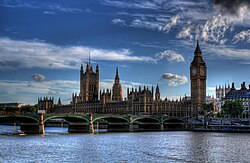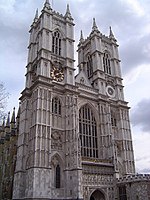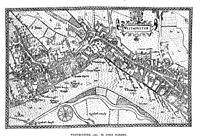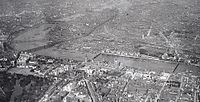Westminster: Difference between revisions
Created page with '{{Infobox town | county = Middlesex | name = Westminster | picture = Hdr parliament.jpg | picture caption = The Palace of Westminster | os grid ref = TQ295795 | latitude = 51.49…' |
More material |
||
| Line 13: | Line 13: | ||
| constituency = Cities of London and Westminster | | constituency = Cities of London and Westminster | ||
}} | }} | ||
'''Westminster''' is a city in [[Middlesex]]. | '''Westminster''' is a city in [[Middlesex]]. It is the effective capital of the United Kingdom, and its heart reflects its history; a mixture of the mediaeval and the attributes of a grand imperial capital. It stands on the north bank of the [[River Thames]], immediately to the west of the [[City of London]] and completely contiguous with it; the boundary between the two cities was once the [[River Fleet]], though the Corporation of London has since managed to expand its bounds a little west across the Fleet valley. | ||
Here are found all the organs of rule and government: Buckingham Palace is the Queen's town residence and around Parliament Square stands the homes of Parliament, the chief offices of state, the Supreme Court of the United Kingdom, and the church represented grandly in Westminster Abbey. With these and other, Westminster has a large concentration of London's historic and prestigious landmarks and visitor attractions. | |||
{{ | Westminster has been the seat of the British government, and before it the English government, for almost a thousand years. In Westminster stands the Palace of Westminster, which houses the Parliament of the United Kingdom. This position as the effective capital of the United Kingdom and the expansion of commerce and dwellings beyond the relatively constricted bounds of London have long since enabled Westminster to exceed its once dominant neighbour in size and population and retail commerce. | ||
==Name== | |||
[[File:Westminster abbey west.jpg|left|thumb|150px|The Abbey's western facade]] | |||
The name ''Westminster'' comes from the Abbey founded here by King Edward the Confessor, and completed shortly before his death in 1066; it was known as the ‘’west mynster’’ (“West minster”), as it lies west of the [[City of London]]. The name was soon attributed to the area about it. King Edward’s abbey is now the Collegiate Church of St Peter at Westminster, or more commonly Westminster Abbey. | |||
The name Westminster now most closely describes the area around Westminster Abbey and Palace of Westminster.<ref>Jacqueline Riding, [http://www.bbc.co.uk/history/trail/church_state/westminster_palace/change_palace_westmin_01.shtml All Change at the Palace of Westminster], [[BBC]]</ref> In a wider sense it applies to the wider City of Westminster administratively containing several Middlesex towns and suburbs to the north and west. | |||
"Westminster" is thus often used as a by-name for Parliament and the political community of the [[United Kingdom]] generally. The civil service is similarly referred to by the area it inhabits, "Whitehall", and "Westminster" is consequently also used in reference to the Westminster System, the parliamentary model of democratic government that has evolved in the [[United Kingdom]]. The Westminster System is used with some adaptation in many other nations, particularly in the Commonwealth of Nations and other parts of the former [[British Empire]]. | |||
The term ''Westminster Village'', sometimes used in the context of British politics, employed especially in the phrase ''Westminster Village gossip'', to denotes the close social circle of Members of Parliament, political journalists, spin doctors and others connected to events in the Palace of Westminster. | |||
==Parliament Square== | |||
The heart of Westminster in all its senses is Parliament Square. The square is of relatively recent construction as such but around it are more venerable buildings: | |||
*Westminster Abbey, the oldest building in Westminster, stands to the south side, and with it the Church of St Margaret | |||
*The Palace of Westminster, home to Parliament is on the east side of the square and along the bank of the Thames. | |||
*Whitehall and Downing Street run of the north side of the square, homes respectively of the great Government departments and of the Prime Minister and Chancellor of the Exchequer. | |||
*The [[Middlesex Guildhall]] stands on the west side of the square. Once the headquarters of Middlesex County Council, it is now the home of the Supreme Court. | |||
Thus all the state is represented in order: the Church, Parliament, the Government and the Judiciary. | |||
==History== | |||
[[File:John Norden's Map of Westminster Large version.jpeg|right|thumb|200px|Westminster in 1593]] | |||
[[File:Bird Eye Pictures of London Westminster in 1909.jpg|right|thumb|200px|Bird's eye picture of Westminster in 1909]] | |||
The historic core of Westminster is the former [[Thorney Island, Middlesex|Thorney Island]]; an island formed by the dry ground between two branches of the [[River Tyburn]] and the Thames. Westminster Abbey was built here by King Edward the Confessor and consecrated just a few days before his death in 1066.<ref>{{ASC|E|1066}}: ''On þissum geare man halgode þet mynster æt Westmynster on Cildamæssedæg. 7 se cyng Eadward forðferde on twelfta mæsse æfen.''</ref> | |||
Later that year William the Bastard was crowned King of the English in the Abbey and it became the traditional venue of the coronation. Nearby the Palace of Westminster was built and became the principal royal residence, and later housed the developing Parliament and law courts of England. Thus while the economic capital of the land was in the City of London, its political and cultural capital has been Westminster. This division remains the same today. | |||
The seat of kings later moved to the Palace of Whitehall a little towards the north-east. The law courts have since moved to the Royal Courts of Justice, close to the border of the City of London. The area is still the centre of government, with Parliament now located in the Palace of Westminster and most of the major Government ministries situated in Westminster, centred on Whitehall. | |||
As London became crowded, the entrepreneurs looked west to build new houses. The great developments of Westminster and surrounding districts began apace from the seventeenth century: Downing Street is named after Sir George Downing, who built the street in the 1680s on the site of a mansion called Hampden House. The great estates followed, in particular from the eighteenth century, and strewed the map of the new [[West End of London]] with the names of the great families and their titles. The most exclusive town houses in the country are found amongst these estates today, at the edge of the old heart of Westminster. | |||
The original Westminster has been developed as the capital city of an Empire should; royal palaces and attendant buildings, grand monuments to conquerors and reformers all are to be found thick on the ground here, jostling for space with noble parks. | |||
==The city today== | |||
Close to the Palace of Westminster and Westminster Abbey is Westminster School, one of the leading British public schools. | |||
The area has a substantial residential population, a surprisingly large proportion of which is a traditional London working class community living in council and Peabody Trust estates at the back of Westminster Abbey and off Millbank. | |||
Commerce is found throughout in offices across Westminster and beyond. Oxford Street in the north is the principal retail street with the highest shop rents in the country, catering for the more expensive tastes, but throughout Westminster retail and commercial space is found in abundance. | |||
Along the riverfront is a mixture; at London end the boundary of the cities has the green space of [[Inns of Court|the Temples]], then soon the old Savoy Liberty, still a distinctive place owned by the Duchy of Lancaster, then the headquarters of several large concerns. Inland just a step or two are busy shopping streets with office and flats above. | |||
==References== | |||
;Notes | |||
{{reflist}} | |||
;Bibliography | |||
{{refbegin}} | |||
* Manchee, W. H. (1924), ''The Westminster City Fathers (the Burgess Court of Westminster) 1585–1901: Being some account of their powers and domestic rule of the City prior to its incorporation in 1901''; with a foreword by Walter G. Bell and 36 illustrations which relate to documents (some pull-outs) and artefacts. London: John Lane (The Bodley Head). | |||
* Davies, E. A. (1952), ''An Account of the Formation and Early Years of The Westminster Fire Office''; (Includes black-and-white photographic plates with a colour frontispiece of 'A Waterman' and a foreword by Major K. M. Beaumont. London: Country Life Limited for the Westminster Fire Office. | |||
* Hunting, P. (1981), ''Royal Westminster''. [[The Royal Institution of Chartered Surveyors]]. Printed by Penshurst Press. ISBN 0-85406-127-4 (paper); ISBN 0-85406-128-2 (cased). | |||
{{refend}} | |||
==Outside links== | |||
*[http://www.westminster.gov.uk/ Westminster Borough Council] | |||
*[http://www.gardenvisit.com/travel/london/3_westminster.htm Westminster Walks - from Findlay Muirhead's 1927 guidebook to ''London and its Environs''] | |||
*[http://www.gutenberg.org/etext/21648 Westminster], by Sir Walter Besant and Geraldine Edith Mitton and A. Murray Smith, 1902, from Project Gutenberg | |||
*[http://www.abandonedcommunities.co.uk/palmer's%20village.html Palmer's Village, a deserted village in Westminster] | |||
Revision as of 17:58, 23 November 2012
| Westminster | |
| Middlesex | |
|---|---|
 The Palace of Westminster | |
| Location | |
| Grid reference: | TQ295795 |
| Location: | 51°29’58"N, 0°7’60"W |
| Data | |
| Post town: | London |
| Postcode: | SW1 |
| Dialling code: | 020 |
| Local Government | |
| Council: | Westminster |
| Parliamentary constituency: |
Cities of London and Westminster |
Westminster is a city in Middlesex. It is the effective capital of the United Kingdom, and its heart reflects its history; a mixture of the mediaeval and the attributes of a grand imperial capital. It stands on the north bank of the River Thames, immediately to the west of the City of London and completely contiguous with it; the boundary between the two cities was once the River Fleet, though the Corporation of London has since managed to expand its bounds a little west across the Fleet valley.
Here are found all the organs of rule and government: Buckingham Palace is the Queen's town residence and around Parliament Square stands the homes of Parliament, the chief offices of state, the Supreme Court of the United Kingdom, and the church represented grandly in Westminster Abbey. With these and other, Westminster has a large concentration of London's historic and prestigious landmarks and visitor attractions.
Westminster has been the seat of the British government, and before it the English government, for almost a thousand years. In Westminster stands the Palace of Westminster, which houses the Parliament of the United Kingdom. This position as the effective capital of the United Kingdom and the expansion of commerce and dwellings beyond the relatively constricted bounds of London have long since enabled Westminster to exceed its once dominant neighbour in size and population and retail commerce.
Name

The name Westminster comes from the Abbey founded here by King Edward the Confessor, and completed shortly before his death in 1066; it was known as the ‘’west mynster’’ (“West minster”), as it lies west of the City of London. The name was soon attributed to the area about it. King Edward’s abbey is now the Collegiate Church of St Peter at Westminster, or more commonly Westminster Abbey.
The name Westminster now most closely describes the area around Westminster Abbey and Palace of Westminster.[1] In a wider sense it applies to the wider City of Westminster administratively containing several Middlesex towns and suburbs to the north and west.
"Westminster" is thus often used as a by-name for Parliament and the political community of the United Kingdom generally. The civil service is similarly referred to by the area it inhabits, "Whitehall", and "Westminster" is consequently also used in reference to the Westminster System, the parliamentary model of democratic government that has evolved in the United Kingdom. The Westminster System is used with some adaptation in many other nations, particularly in the Commonwealth of Nations and other parts of the former British Empire.
The term Westminster Village, sometimes used in the context of British politics, employed especially in the phrase Westminster Village gossip, to denotes the close social circle of Members of Parliament, political journalists, spin doctors and others connected to events in the Palace of Westminster.
Parliament Square
The heart of Westminster in all its senses is Parliament Square. The square is of relatively recent construction as such but around it are more venerable buildings:
- Westminster Abbey, the oldest building in Westminster, stands to the south side, and with it the Church of St Margaret
- The Palace of Westminster, home to Parliament is on the east side of the square and along the bank of the Thames.
- Whitehall and Downing Street run of the north side of the square, homes respectively of the great Government departments and of the Prime Minister and Chancellor of the Exchequer.
- The Middlesex Guildhall stands on the west side of the square. Once the headquarters of Middlesex County Council, it is now the home of the Supreme Court.
Thus all the state is represented in order: the Church, Parliament, the Government and the Judiciary.
History


The historic core of Westminster is the former Thorney Island; an island formed by the dry ground between two branches of the River Tyburn and the Thames. Westminster Abbey was built here by King Edward the Confessor and consecrated just a few days before his death in 1066.[2]
Later that year William the Bastard was crowned King of the English in the Abbey and it became the traditional venue of the coronation. Nearby the Palace of Westminster was built and became the principal royal residence, and later housed the developing Parliament and law courts of England. Thus while the economic capital of the land was in the City of London, its political and cultural capital has been Westminster. This division remains the same today.
The seat of kings later moved to the Palace of Whitehall a little towards the north-east. The law courts have since moved to the Royal Courts of Justice, close to the border of the City of London. The area is still the centre of government, with Parliament now located in the Palace of Westminster and most of the major Government ministries situated in Westminster, centred on Whitehall.
As London became crowded, the entrepreneurs looked west to build new houses. The great developments of Westminster and surrounding districts began apace from the seventeenth century: Downing Street is named after Sir George Downing, who built the street in the 1680s on the site of a mansion called Hampden House. The great estates followed, in particular from the eighteenth century, and strewed the map of the new West End of London with the names of the great families and their titles. The most exclusive town houses in the country are found amongst these estates today, at the edge of the old heart of Westminster.
The original Westminster has been developed as the capital city of an Empire should; royal palaces and attendant buildings, grand monuments to conquerors and reformers all are to be found thick on the ground here, jostling for space with noble parks.
The city today
Close to the Palace of Westminster and Westminster Abbey is Westminster School, one of the leading British public schools.
The area has a substantial residential population, a surprisingly large proportion of which is a traditional London working class community living in council and Peabody Trust estates at the back of Westminster Abbey and off Millbank.
Commerce is found throughout in offices across Westminster and beyond. Oxford Street in the north is the principal retail street with the highest shop rents in the country, catering for the more expensive tastes, but throughout Westminster retail and commercial space is found in abundance.
Along the riverfront is a mixture; at London end the boundary of the cities has the green space of the Temples, then soon the old Savoy Liberty, still a distinctive place owned by the Duchy of Lancaster, then the headquarters of several large concerns. Inland just a step or two are busy shopping streets with office and flats above.
References
- Notes
- ↑ Jacqueline Riding, All Change at the Palace of Westminster, BBC
- ↑ Anglo-Saxon Chronicle Laud Chronicle (1066): On þissum geare man halgode þet mynster æt Westmynster on Cildamæssedæg. 7 se cyng Eadward forðferde on twelfta mæsse æfen.
- Bibliography
- Manchee, W. H. (1924), The Westminster City Fathers (the Burgess Court of Westminster) 1585–1901: Being some account of their powers and domestic rule of the City prior to its incorporation in 1901; with a foreword by Walter G. Bell and 36 illustrations which relate to documents (some pull-outs) and artefacts. London: John Lane (The Bodley Head).
- Davies, E. A. (1952), An Account of the Formation and Early Years of The Westminster Fire Office; (Includes black-and-white photographic plates with a colour frontispiece of 'A Waterman' and a foreword by Major K. M. Beaumont. London: Country Life Limited for the Westminster Fire Office.
- Hunting, P. (1981), Royal Westminster. The Royal Institution of Chartered Surveyors. Printed by Penshurst Press. ISBN 0-85406-127-4 (paper); ISBN 0-85406-128-2 (cased).
Outside links
- Westminster Borough Council
- Westminster Walks - from Findlay Muirhead's 1927 guidebook to London and its Environs
- Westminster, by Sir Walter Besant and Geraldine Edith Mitton and A. Murray Smith, 1902, from Project Gutenberg
- Palmer's Village, a deserted village in Westminster